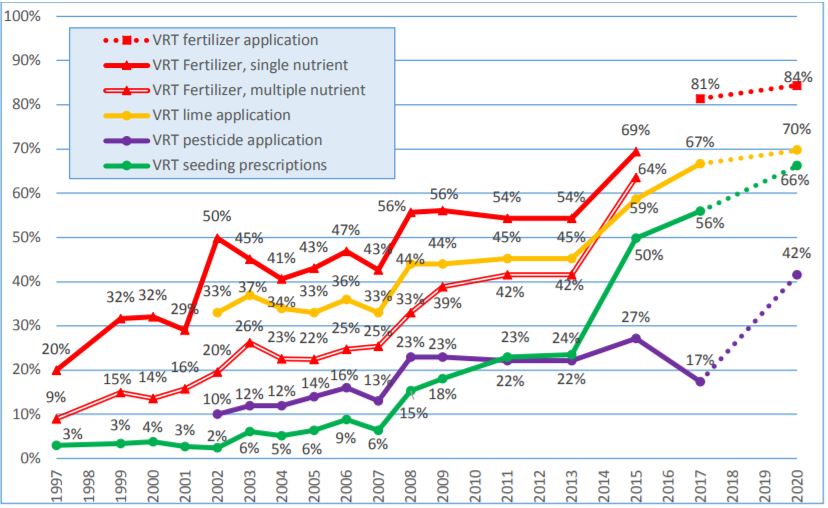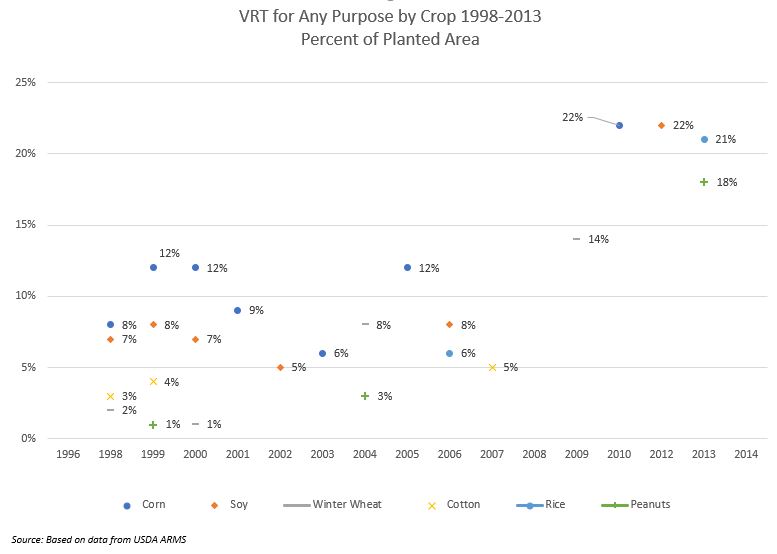Our most recent contributed content article for Global AgInvesting’s AgTech Intel Newsletter. A concise, to-the-point commentary piece on Variable Rate Technology (VRT), adoption challenges, and what the future may hold. Many thanks to George Varvarelis and the Augmenta team for co-authoring this article and continuing to lead innovation in the sector. If you’re in California for the World Ag Expo this week, stop by Building C, Booth 3830 to visit with the team.
By Michael DeSa of AGD Consulting and George Varvarelis of Augmenta
Imagine you’re at the county fair with your date, casually strolling the grounds, watching ring toss games and listening to the joyful screams from the kids on the ferris wheel. Inevitably, you stumble across the fortune tellers and palm readers. Some people are passionate professors of this craft, while others are strict non-believers. Most, however, are willing to try it out of sheer curiosity, so long as it’s not too expensive. The adoption of Variable Rate Technology (VRT) — an application allowing farmers to apply different rates of crop inputs at each location across their fields — appears to have evolved in a similar fashion; some being true believers, but most only willing to put their toes in the water. We’ll take a deeper dive into VR tech, the headwinds facing a more widespread adoption, and what the future may hold.
What Problem is VRT Trying to Solve?
One of the indisputable facts we’ve learned in the last 15 to 20 years is that field variability is a real thing. Every farmer’s field has different agronomic needs, weather patterns, and soil profiles. As a result of this field variability, most farmers suffer some form of loss due to underperforming crops and overspend in inputs. VRT describes any technology that enables producers to vary the rate of crop inputs using a combination of variable-rate (VR) control systems with applications equipment, to apply inputs at a precise time and/or location to achieve site-specific application rates. However, if VRT was designed to solve a problem most of us agree exists, why have adoption rates been so slow?
VRT Adoption – How Does it Compare?
Like most things in agriculture, economic incentive and immediate need are two primary drivers for precision ag adoption, including VRT. By the end of 2017, for example, nearly 80 percent of U.S. ag retailers had adopted some form of GPS guidance[1]. Given that most U.S. farmers access new agtech through retailers, it’s safe to say guidance systems have been generally adopted by mechanized farmers worldwide. Why? Because the immediate benefits were very clear, the technology was easy to use, and the ROI was short and compelling. To the contrary, farmer up-take of VRT has been comparatively lower, rarely exceeding 20 percent anywhere in the world for cereals and oilseeds. These adoption rates indicate an “experimental” level of acceptance[2]. In spite of the widespread availability for VRT services indicated by Figure 1 and intense publicity and subsidies in some countries and states, VRT use by farmers has rarely broken this threshold.
Figure 1 – Dealers Offerings of Precision Services, Variable Rate Technology

Figure 2 – VRT Adoption Purposes by Crop 1998- 2013
Challenges with Current VRT
Many of these headwinds to VRT adoption stem from the inadequacies of the technology and/or methodology used. First, ag retailers who offer Variable Rate Application (VRA) mapping generally do so as an add-on service to soil sampling. The problem with this methodology is that soil sampling data used to create VR prescription maps does not accurately consider nitrogen levels throughout the farm. In fact, nitrogen in nitrate form is evaporated by the time many of these samples reach the lab.
Drones and satellites are also commonly used today to create NDVI maps from which variable rate prescription maps are derived. NDVI maps tell a farmer how much more near-infrared light is reflected compared to visible red light. When translated into actionable data, it can provide insight into a variety of agronomic issues, but doesn’t specifically pinpoint why the crop is stressed (poor nutrition, disease, lack of water, or fertilizer, etc.). Further, the quality of the NDVI map is directly related to the sensor’s altitude and resolution. Logistics, high technical skills requirements, data transmission latency, and weather limitations all impact the use of drones/satellites for VR prescription mapping. While the use of VRT on tractors to enable mechanized input applications is a well-developed landscape, their effectiveness is still limited by the quality of the NDVI sensor.
Finally, many prescription maps today rely on a combination of soil samples (often taken only once per every acre or two) and drone/satellite NDVI imagery to create accurate enough maps in which to base agronomic decisions. With nitrogen fertilization windows being narrow and unpredictable, neither of these solutions allow the grower to capitalize on these maps in real-time.
What Must Change?
In order for VRT to break through the 20 percent adoption ceiling, it must make economic sense for the farmer. It must consistently illustrate that it helps increase yields and reduce input costs, ideally in the double-digit range. It must be easy-to-use and compatible with existing GPS systems. It must eliminate the high cost of site-specific information requirements (soil sampling) and developing individual prescription maps. The technology must be scalable and customizable to read more than one crop type without complicated configuration or retrofitting. Higher resolution, camera-based systems utilizing computer vision and machine learning are likely steps in the right direction. The solution must be able to be applied in real-time, and for commodity growers, grain prices may also need to improve before many will consider adoption.
Finally, the cost of being wrong must be cushioned by incentives for early adopters. Trial lease periods with free support, integration at grower co-ops and ag retailer levels first, and economic incentives from the downstream use of farmer data are just a few examples. In order for this to work, the bold must be rewarded by early fortune.
Find out more about Augmenta at www.augmenta.ag
About the Authors:
Michael DeSa is the founder/managing director of AGD Consulting, a U.S.-based, strategic advisory and business development firm servicing the agricultural and resource sectors in emerging and OECD markets. Services include farmland and agribusiness due diligence, project origination, market assessment, and competitive analysis for precision ag technology and international project management. DeSa can be reached at michael@desaconsultingllc.com.
George Varvarelis is the founder/CEO of Augmenta, a precision agriculture technology company. Varvarelis was a Ph.D. candidate in computer and embedded systems engineering while managing his family farms before deciding to put his engineering expertise into action to create scalable solutions for large-scale farming. Augmenta’s mission is to connect the dots of the global agriculture ecosystem and to augment the capacity of the arable land. Varvarelis can be reached at george@augmenta.ag.
[1] Bruce Ericksonet, James Lowenberg-DeBoer, and Jeff Bradford. (Dec 2017). 2017 Precision Agriculture Dealership Survey. Retrieved from the Departments of Agricultural Economics and Agronomy, Purdue University. http://agribusiness.purdue.edu/files/file/croplife-purdue-2017-precision-dealer-survey-report.pdf
[2] Professor Lowenberg-DeBoer, James. “Economic Considerations for Agricultural Big Data.” PowerPoint, Identifying Obstacles to Applying Big Data in Agriculture Conference, Houston, TX USA, August 20-21 2018.

